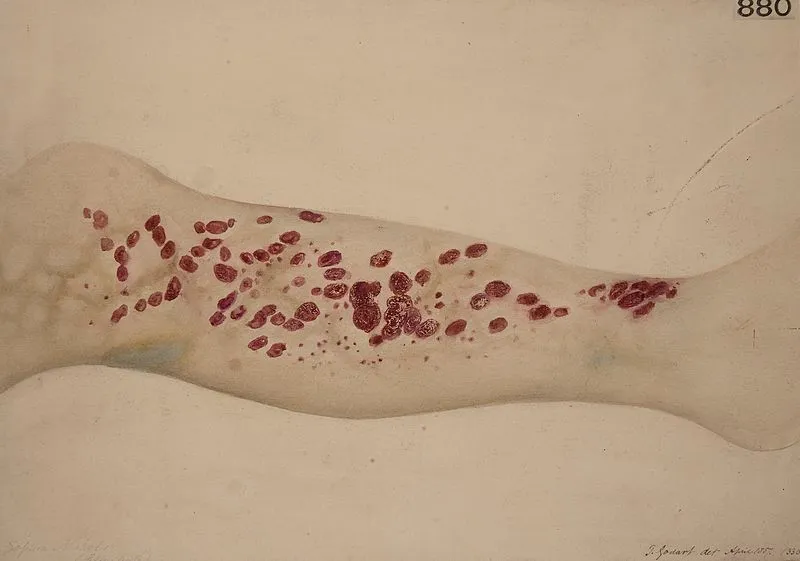It is another day in the health world, and we will be looking at a medical case of a woman who presented to the hospital with bilateral pain in her legs that prevented her from walking. This particular presentation got doctors in the hospital confused as they were unable to pinpoint the right cause of her condition until thee right questions were asked, and a simple blood test done to reach a diagnosis.
Meet a 54-year-old woman who, by all accounts, was quite active in her daily life. Holding a full-time job and remaining mobile, she initially attributed her growing fatigue and knee pain to her daily activities. However, as time passed, the pain descended from her knees to her shins and calves, becoming increasingly intolerable.

As usual, there is this doctor in us, so she became her own little orthopedic doctors and began to do some stretching and minor massages but then the pain didn't reduce, instead she began to see bruising at the back of her legs without bumping into something or cutting herself. She began to see red dots in her legs and this became a thing of concern but since they were not painful or itchy, she just didn't worry much and hoped that it would go away by itself.
But as the pain intensified day by day, she decided it was time to seek professional medical attention. Upon visiting the hospital, the situation took a different turn. The patient presented with mild tachycardia (an elevated heart rate of 103 beats per minute), although she did not have a fever or high blood pressure. Physical examination revealed additional distressing symptoms, including a rash, small knee effusions, and mild bilateral pitting edema (swelling) in her lower limbs. The patient's calves were particularly painful in relation to the swelling and rash.
There are possible causes of this, and it could be a blood clot in the vessel which could travel to the heart or lungs leading to fatal results so to rule out possible clotting, an Ultrasound was requested for the patient but then, it was normal as there was no sigh of a blood clot. With that rulled out, is it possible that it has to do with the bones in her legs, and this is where an X-ray is very important to check for a fracture, infection, or possibly a tumor but there was nothing wrong with the bones or joint but showed prominent subcutaneous and deep fascial edema. This was seen in the gastrocnemius muscles bilaterally, and in the calves.
This showed that there might be something wrong with one of these organs; the heart, liver, or kidneys but her condition didn't fit those. So an MRI was done on he legs and it showed the edema in the deep facial as well as the subcutaneous tissues so this might be a response to an inflammatory condition. These conditions could be cancer, Trauma, Diabetic myonecrosis, infection, inflammatory myopathy, vasculitis, Polymyosites, dermatomyositis, or possibly taking certain medications.

To rule out cancer, a CT scan of her chest, abdomen, and pelvis was done and it came back normal, she also was a non-smoker, didn't have diabetes, and didn't suffer from any type of trauma either social or financial stressors. An Electromyography (EMG) was requested which is to test the electrical activity produced by the muscle and it came back normal. While these tests were normal, one test came back with a little problem when she got into the hospital, and that was her blood test that showed she was Anemic (low red blood cells) with a hemoglobin of 96g/L while the normal hemoglobin is within 115 and 155 g/L. Another blood test was done after days in the hospital and this came back showing her hemoglobin level to be 73g/L.
For people with anemia, if a person is low in iron, the red blood cell is small, and if it is a case of vitamin B12 being low, then the red blood cell will be big but for the patient, the red blood cell was normal and this will lead to checking if the body is producing enough red blood cell. To identify this, a Reticulocyte count is done to check the if the bone marrow is producing enough new cells and this also came back positive.
This outcome directed their attention to the possibility of the red blood cells either escaping due to bleeding or dying prematurely (hemolysis). Blood work indicated that the red blood cells were not experiencing early destruction, which left blood loss as a probable explanation. Could the red blood cell loss be related to the petechiae (rash) present on her body, which typically results from red blood cell leakage through tiny capillaries in the skin?
A skin punch Biopsy was then done on the patient but then this could take a long time but the result came back showing noninflammatory dermal hemorrhages. Going back to the patients medical history, the patient’s medical history included osteoarthritis and osteoporosis and she took medications which included alendronate, calcium, vitamin D and acetaminophen but had stopped taken fruits and vegetables due to allergies as she was allergic to sulfa, penicillin, codeine and nuts.
This insightful history raised suspicions regarding her vitamin C levels, leading to a revelation. It was discovered that the patient was suffering from scurvy, a condition most believe to be a relic of the past. Vitamin C, or ascorbic acid, plays a crucial role in numerous physiological processes, including hydroxylation reactions necessary for procollagen production. It also contributes to the production of L-carnitine, which facilitates the conversion of fat into ATP, offering an explanation for her overwhelming fatigue.
Vitamin C is also vital in the synthesis of norepinephrine and adrenaline and is involved in collagen production, essential for the health of the skin, blood vessels, bones, and overall structural integrity. Scurvy results in abnormal connective tissues, potentially leading to muscle and tissue bleeding, reduced hemoglobin levels (anemia), and other manifestations that confirmed the diagnosis.
The patient was treated for scurvy but then you might be wondering that scurvy is a disease know to affect sailors. Well, it has been for a very long time which was written by the Egyptians over 3000 years ago where they even mentioned that eating onions was good way to treat it. It would cause people to have bleeding gums, brittle bones, falling teeth, bruises, and so on. While some people looked into taking citrus fruits as a remedy, it was proven by Sir James Lind in the 1700s. To avoid scurvy, women need to ingest at least 75 milligrams daily of vitamin C, while men ingest 90 milligrams daily.
Read More
https://www.cmaj.ca/content/183/11/E752#F3
https://ods.od.nih.gov/factsheets/VitaminC-HealthProfessional/
https://www.sciencedirect.com/science/article/abs/pii/S1043452617300426?via%3Dihub
https://www.unlockfood.ca/en/Articles/Vitamins-and-Minerals/What-you-need-to-know-about-vitamin-C.aspx
https://www.ncbi.nlm.nih.gov/books/NBK493187/
https://www.nhs.uk/conditions/scurvy/
https://www.ncbi.nlm.nih.gov/pmc/articles/PMC6049644/
https://www.msdmanuals.com/home/disorders-of-nutrition/vitamins/vitamin-c-deficiency
Image Reference
Image 1 || Picryl || Emergency room personnel at Kuakini Hospital remove an accident
Image 2 || Wikimedia Commons || Leg of a patient with scorbutus (scurvy
https://ods.od.nih.gov/factsheets/VitaminC-HealthProfessional/
https://www.sciencedirect.com/science/article/abs/pii/S1043452617300426?via%3Dihub
https://www.unlockfood.ca/en/Articles/Vitamins-and-Minerals/What-you-need-to-know-about-vitamin-C.aspx
https://www.ncbi.nlm.nih.gov/books/NBK493187/
https://www.nhs.uk/conditions/scurvy/
https://www.ncbi.nlm.nih.gov/pmc/articles/PMC6049644/
https://www.msdmanuals.com/home/disorders-of-nutrition/vitamins/vitamin-c-deficiency
Image Reference
Image 1 || Picryl || Emergency room personnel at Kuakini Hospital remove an accident
Image 2 || Wikimedia Commons || Leg of a patient with scorbutus (scurvy